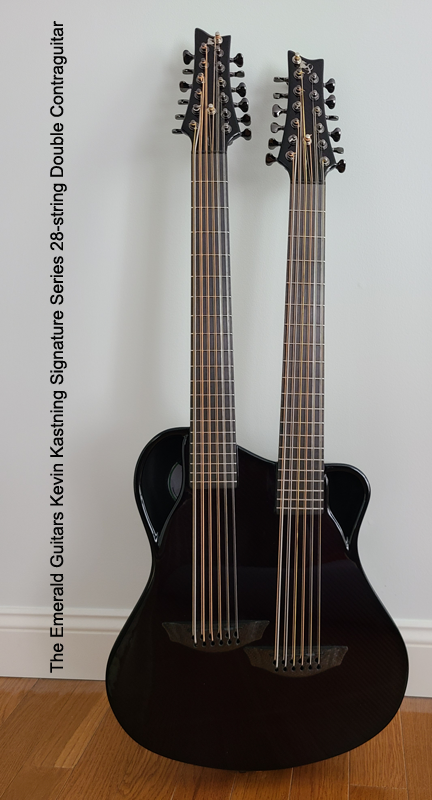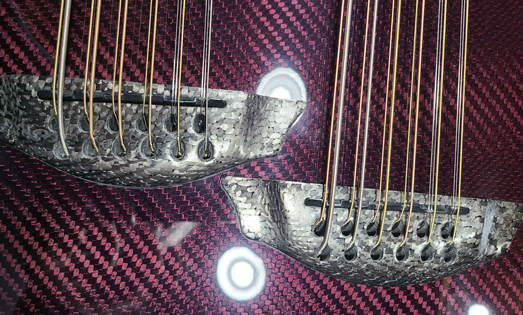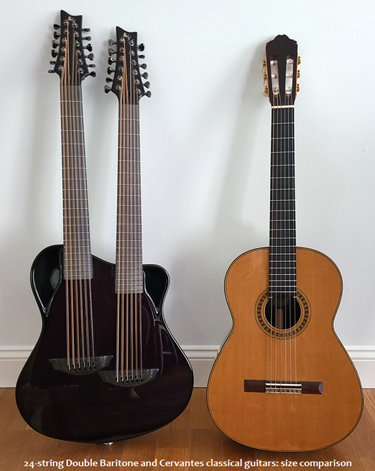
Tuner Configuration

Update: May 2023
I modified the 24-string Double Baritone into the 28-string Double Contraguitar. This is a doubleneck instrument, with the first two courses on both necks being triple courses. This instrument is currently in E contra tuning.
I modified my Martin X-12 such that the top three treble courses
are now triple courses, making the X-12 into the X-15, a 15-string Baritone.
The concerns I had with triple courses on the Martin made me suspect that these
concerns would likely be resolved on a carbon fiber instrument. Indeed,
carbon fiber with its high degree of responsiveness over wood eliminated the
few drawbacks I was experiencing on the Martin. Techniques such as tapping,
two-handed techniques, and legato playing are much more
responsive, accessible, and articulate on the 28-string Double Contraguitar.
of responsiveness over wood eliminated the
few drawbacks I was experiencing on the Martin. Techniques such as tapping,
two-handed techniques, and legato playing are much more
responsive, accessible, and articulate on the 28-string Double Contraguitar.
This is an exciting discovery. Triple courses open up entirely new harmonic
paths and harmonic possibilities otherwise unattainable.
![]() ast
week, the Emerald Guitars KK Signature Series
24-string Double Baritone guitar
arrived. It has been in the works for over a year, and was well worth the wait.
ast
week, the Emerald Guitars KK Signature Series
24-string Double Baritone guitar
arrived. It has been in the works for over a year, and was well worth the wait.
The concept is that of a doubleneck utilizing a pair of 12-string necks. Each
side is tuned to a baritone tuning, but each tuning is different. The left side
is in F# baritone tuning, which is one whole step above a bass or E
Contraguitar, or a minor 7th below concert guitar tuning. The right side is in A
baritone tuning, which is a fourth above bass or E Contraguitar, and a fifth
below concert tuning. Each side is in one of my intervallic tunings, but they
are not the same intervallic tunings.
Two different registers. Two different tunings.
The 24 provides two distinct voices, registers, and tunings. The F# and A registers are not quite a low as a Contraguitar in E or D, but is below the baritone registers, which are usually in B or C.
It is a true 24-string instrument, as both necks are played simultaneously.
The body depth is thinner than any of my other acoustic instruments. In the world of wood guitars, a shallower body depth means less bass response and a thinner midrange, resulting in an unbalanced voice. However, with carbon fiber instruments, the limitations of wood instruments no longer applies. The voice is balanced, resonant, and rather loud. Additionally, the 28 has the incredible responsiveness and the perfect balance found in carbon fiber instruments, which I find, at least for my playing directions, to be superior to wood instruments. The voice is very unusual, with hints of harpsichord, bass, and piano. The upper registers have a very cello-like quality.
The custom stereo K&K pickup system sounds like beautiful stereo microphones. And with two sound holes on either side of the body, it is a true acoustic stereo instrument. Using a stereo pair of microphones in the studio renders a wondrous result.
When I designed the 24 over a year ago, I had specified the two tunings as D (down one whole step from concert E; not a baritone tuning), and A (down a fifth from concert E, which is a baritone tuning). I put together the string sets for those tunings and sent them to Alistair at Emerald Guitars, and that is how it was set up when it arrived.
I wanted the tunings to be lower, and for both tunings to be baritone tunings.
Yet I wanted two different registers. I had been doing research on this
using my Martin 12-strings, and I know that with the proper gauges I can go to A
baritone (octaves on all courses; no unisons) and even G baritone. I wouldn't
want to attempt anything lower than that on the Martins, as each time I drop the
tuning lower, the string gauges must get heavier. Additionally, the necks must be adjusted, and usually I have to make a new
bridge saddle for radically different tunings or registers.
Additionally, the necks must be adjusted, and usually I have to make a new
bridge saddle for radically different tunings or registers.
I have the F# tuning and string gauges that I used when the 12-string Santa Cruz Contraguitar was set up and used as a baritone. This tuning is one whole step above bass E tuning, or you could also think of it as a minor seventh below concert E. The gauges range from .080 to .011. I had a very strong feeling, based on my Martin 12-string baritone research, that I could indeed get an F# baritone tuning in a 650mm scale if the instrument could handle the much heavier string gauges, and of course this is not an issue for carbon fiber instruments.
After playing the 24 for a few days, I was certain that I could retain the A baritone tuning and change the D tuning to F#. This would provide two entirely baritone tunings, but still in different registers, with the registers being a minor third apart. And both sides would be in intervallic tunings, but not the same intervallic tuning. Two registers, two tunings, on one instrument.
On my doublenecks, there is always a neck that I use as the primary one. On the 30, it's the Contra side. On the 36, it's the intervallic tuning side. In each case, the neck I use the most is always the left neck, as it's more comfortable of a reach and the positioning is perfect. So on the 24, I know I'm going to be using the F# tuning the most, so I wanted that tuning to be on the left neck. "Left" meaning my left when I'm playing.
In the original 24 specification, I assigned the A tuning to the left side and the D tuning to the right. So, for me to change the tunings from A/D to F#/A, I'd need to move the A tuning to the R side and then set up the F# tuning on the L side. Of course this is not as easy as it sounds, as the nuts and saddles were set up for A/D tunings, not F#/A tunings. I re-cut nut slots as needed to accommodate the heavier gauges. I shaved the base of the D tuning saddle to be a tiny bit (~ 0.5mm) lower than the A saddle, as the F# strings are so much heavier than the A tuning's strings. I also had to remove the low F# string's tuner and drill out the string hole in the post, as it was too small to accept an .080 gauge string. The tuners are Gotoh 510 series.
After the new F# and A tuning strings were on, I needed to adjust both truss rods a bit. Now it has very low action and feels great. I went lighter with these gauges back when I used these same gauges on the Santa Cruz, but now keeping strings as light as possible is not a limitation with the carbon fiber instruments, hence the gauges for the new F# tuning are bit more robust than the gauges in my old F# tuning.
The next project was moving the output jack. It was in a bad location; when in cello position, my left leg blocked it. Originally, the output jack was several inches away from the cello fitting on the left side. I relocated it to the right side, and about an inch away from the cello pin. That puts it completely out of the way when playing, and makes plugging in/out easier and more accessible. I sealed the old jack hole with a black nylon grommet plug, making the old hole almost unnoticeable.
It sounds amazingly great. The F# tuning is very resonant and full, and the A tuning provides a slightly brighter, yet still baritone and very rich, voicing.
I've done some test recordings with it in the studio. On tape, it sounds rather massive.
The 24 will be one of my main instruments going forward, and will regularly be utilized on upcoming album recording projects. In fact, I used it, along with the 36-string Double Contraguitar, on the August 2022 recording sessions with pianist Laszlo Gardony.
To Alistair Hay and everyone at Emerald Guitars Ireland: my sincere gratitude.
- Kevin Kastning
August 2022